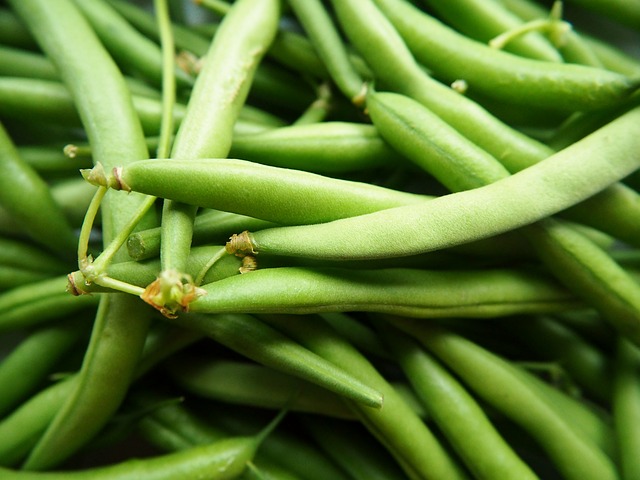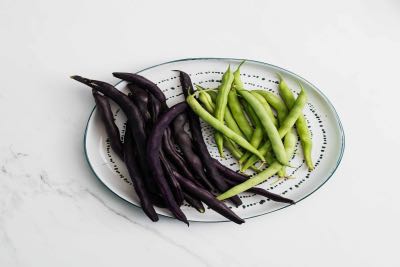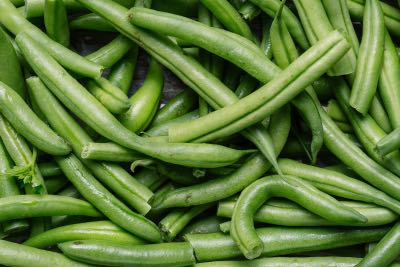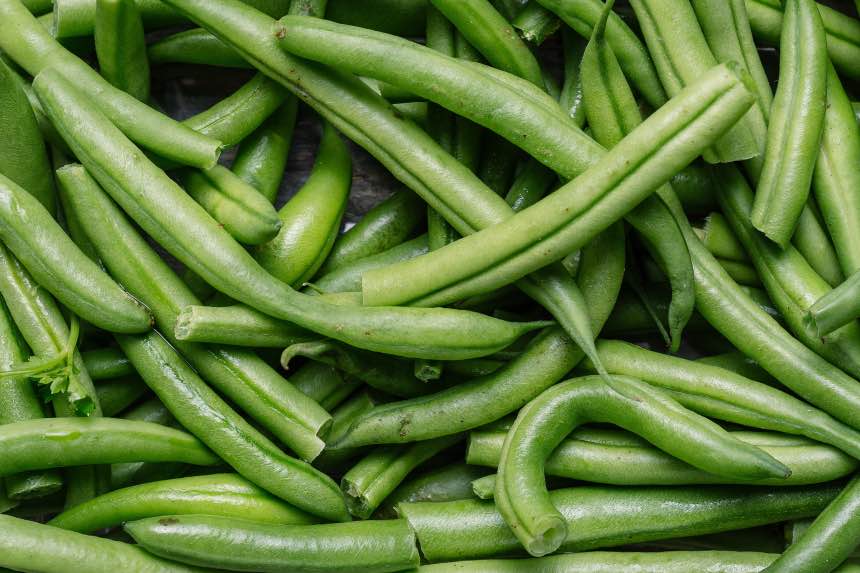Green beans are a popular and delicious vegetable that is easy for any level of gardener to grow. Whether you prefer them purple, red, yellow, or green, beans are nutrient powerhouses perfect for any snack or dish while providing stunning visual interest. Let’s discover how you can easily start growing green beans indoors!
How to Grow Green Beans Indoors
For this guide, we’ll be growing beans from seeds as they’re easier to cultivate in comparison to transplants. Buying seedlings to transplant is a valid option, but I find it easier and more fun to start with seeds. In either case, the care is the same so you can go with whichever method you prefer. Now, prepare your soil, sow your seeds, and brace yourself for the pursuit of pod perfection!
Find the Perfect Green Bean Variety
When it comes to green beans, there is a wide range of options available. We recommend considering smaller varieties unless you have ample space indoors to cultivate the larger varieties.
For indoor cultivation of green beans, compact or bush varieties are preferable due to their limited growth compared to pole or vining types. Some well-known options include Provider, Contender, and Blue Lake Bush.
However, it is important to note that these examples represent only a fraction of the extensive variety of green beans. Numerous other options exist, each possessing its unique appeal. When making your choice, factors like taste preferences, growth habits, disease resistance, and suitability for container gardening should be taken into account.
Keep an eye out for varieties labeled as “bush” or “compact” as they align well with your goals for indoor gardening. Additionally, you may come across “dwarf” green bean varieties during your search.
These compact gems are specifically bred for smaller spaces and container gardening, taking compactness to a new level. They could potentially be excellent companions for your indoor growing endeavors.

Blue Lake
The traditional green bean, this bush variety produces beans about 6" in length and its small size, compact size makes it an excellent choice for indoor cultivation.
Blue Lake Seeds
Royal Burgundy
This variety grows sweet beans that are a purplish color adding some visual flair to your garden. This is also a bush variety, so its good for indoor growing.
Royal Burgundy Seeds
Jade
Jade is another bush variety of green beans that produces beans similar in size to Blue Lake. The main differences are that jade is a bit sweeter tasting, and it doesn't produce strings.
Jade Bean SeedsSelect the Right Plant Container
When it comes to selecting the perfect home for your indoor bean-growing adventures, consider both aesthetics and practicality. Opt for a receptacle that provides ample space for root respiration, targeting a depth of approximately eight to ten inches.
This size gives your plant’s roots enough space to grow. In terms of width, look for at least 12” of space. This will give you more than enough room to grow a green bean plant.
Now, let’s discuss a crucial aspect: proper drainage. Ensure that your chosen container has drainage holes at its base. This lets excess water escape and helps prevent root rot.
Whether you opt for vessels crafted from plastic or ceramic, wooden crates, or even repurposed treasures, such as buckets or robust grow bags, all these options possess the capability to work their purpose. The choice of material is entirely yours, as long as it provides proper drainage it will work.
Prepare the Soil
Get yourself a potting mix that knows how to drain well. Look for one that’s labeled as suitable for container gardening, usually, this will be labeled as potting soil. You can either snag a ready-made mix from a garden center or whip up your own by blending equal parts compost, peat moss, and perlite.
This makes sure that your bean plants get the right amount of air, moisture, and nutrients to keep those beans happy. Now, fill up your container with the potting mix, but be sure to leave a bit of space at the top. Gently pat down the soil in the container, but don’t put too much force. Too much compaction can cramp those precious roots.
Beans prefer slightly acidic soil, with a pH range of 6.0 to 6.8. To get your soil mix’s pH level, grab yourself a soil pH testing kit. If the numbers are outside the ideal range, you can bring them back in line. You can add a sprinkle of lime to lift the pH or some sulfur to give it a little dip, following the instructions on the package.
You can also supplement the soil with some fresh compost or some slow-release fertilizer. This isn’t strictly necessary but can help improve the nutrient content of your soil.
Before you get down to sowing those seeds, give the potting mix a gentle shower. We’re talking moist, not soaked. Going overboard with the watering can spell trouble, like root rot and fungal growth.
Sow the Green Bean Seeds
Take a moment to gently press them into the soil about one to two inches deep. Give each seed a bit of personal space, spacing them approximately two to three inches apart. After all, even seeds need a little breathing room to sprout and become strong, independent plants.
If you’re dealing with a larger container, it’s your chance to play architect and create some rows. Aim for a spacing of four to six inches between each row. Plant those seeds in nice, neat rows, maintaining that same spacing between individual seeds.
At this point, it’s okay if the container feels a little crowded. Not all the seeds will sprout, and some might not make it past the seedling stage. Just thin out the weaker seedlings once they’ve sprouted, giving the remaining plants the space they need to flourish.
You have to remember though that each green bean variety has its preferences when it comes to planting depth and spacing. So, be sure to check the specific guidelines for the cultivar you’re growing. They might have their own little quirks and preferences, just like any other living being.

Tip
If starting with seedlings, make sure to provide enough space between each one. I like to give each one about 10-12” of space to ensure it has enough room.
Provide Adequate Light
Find a sunny spot in your abode where those beans can bask in the glow of six to eight hours of direct sunlight per day. While they can survive in partial shade, you’ll end up with slower-growing plants that don’t produce as many harvestable veggies.
Grow lights are a great option if you lack the ability to provide enough natural light. I tend to run my grow lights for about 1.5 hours per 1 hour of natural sunlight. That means, for green beans, look to run your grow light for about 9-12 hours. You can reduce this by providing a mix of natural and artificial light.
The Perfect Amount Of Water
Green beans prefer slightly moist soil but don’t want to sit in a soaking wet medium. Maintaining consistent moisture without making the soil soggy is crucial. To determine the moisture level, assess the soil by inserting your finger approximately one inch deep. If it feels dry at that depth, it indicates the need for watering. If it still feels wet, then your beans can probably go another day or two before needing more water.
When watering your green beans, it is recommended to employ a gentle and gradual approach. Rather than showering them from above, pour water delicately at the plant’s base. Continue pouring until you observe drainage through the container’s bottom holes.
This method ensures the roots receive adequate moisture while minimizing leaf saturation, thus reducing the risk of fungal diseases. It’s essential to avoid the common mistake of overwatering, particularly for inexperienced gardeners.
Proper drainage is vital for green beans. Verify that your container possesses adequate drainage holes at the bottom, facilitating the escape of excess water. If you employ a saucer or tray beneath to collect drainage, remember to regularly empty it to prevent water accumulation and potential issues.
Regarding water quality, it is advisable to address high mineral levels in tap water. Allowing the water to sit overnight in an open container before using it for watering enables mineral dissipation. Alternatively, if possible, consider using a filter or rainwater as preferable options for indoor greenery.
Indoor environments tend to be drier than the outdoors, especially when utilizing air conditioning or heating systems. To maintain suitable humidity levels around your green beans, you can employ a humidifier or position a tray filled with water nearby. As the water gradually evaporates, it creates a more humid atmosphere beneficial for the well-being of your plants.
Support Green Bean Plants
Depending on the type of green bean you’re growing, you may need to add support to help keep it in shape. Typically, bush varieties grow compact enough that this isn’t required. Pole, or vining, varieties though, will oftentimes need support. These varieties have longer vines that like to climb, and giving them room to do so is important for optimal growth.
There are a few options you can consider to offer the needed assistance. One widely used method is to opt for a reliable lattice. Lattices can be created from a variety of materials, such as timber, metal, or even reeds.
Supports, conversely, can be rods made of wood or metal that possess adequate strength to bear the weight of those creeping plants. These are cheap and easy to install, so they make a great choice to help support your growing plant.
In either case, get in the habit of checking your plant’s growth. As the creeping plants continue to grow, gently guide any straying tendrils to encourage them to ascend the lattice or supports. This ensures not only an aesthetically pleasing plant, but also promotes proper growth.
By providing appropriate support for your green bean plants, you will benefit from enhanced air circulation around the foliage, minimize the risk of soil-related diseases, and facilitate easy harvesting. Not to mention, it will also optimize the utilization of vertical space in your indoor garden, enabling you to cultivate a greater quantity of delectable green beans in a confined area.
Fertilize Well
Around three weeks after planting, or once the plants have a sturdy root system, it’s time to start fertilizing. This way, they can soak up those extra nutrients and thrive. Consider going organic with your fertilizers, but you can also opt for inorganic ones too.
Organic fertilizers release nutrients slowly and help keep the soil in tip-top shape. You’ve got some options here, like compost, well-rotted manure, or organic granular fertilizers specially made for veggies. Just follow the instructions on the package to get the right application rates.
Now, when it comes to choosing an inorganic fertilizer, go for one that’s balanced. Look for equal parts nitrogen (N), phosphorus (P), and potassium (K). You’ll see those numbers on the fertilizer packaging, like 10-10-10 or 14-14-14. This balanced blend supports overall plant health, root development, and a good crop of flowers and fruits.
When it’s time to apply the fertilizer, sprinkle it evenly around the base of the plants, making sure to keep it a few inches away from the stems. We don’t want direct contact here. Give the top layer of soil a light raking or use a handy tool to work the fertilizer in, and then water the plants thoroughly. That way, the nutrients dissolve and make their way down to those roots.
Throughout the growing season, plan on fertilizing your green beans every four to six weeks. But, don’t get too trigger-happy with the fertilizer. While most organic fertilizers won’t cause any problems, harsher chemical ones can burn out the plant if applied too often.
In addition to regular fertilizing, you can also give your green beans a boost by adding organic matter to the mix. Think compost or well-rotted manure. These goodies release nutrients slowly, improve soil structure, and help retain moisture. All of that adds up to healthier plants.
Remember to keep an eye on your green bean babies. Watch out for any signs of nutrient issues like yellow leaves, stunted growth, or funky discoloration. Adjust your fertilization routine as needed, and don’t go overboard with the recommended amounts.
Pollinate Your Green Beans
Growing green beans indoors can be quite challenging due to limited airflow and the absence of natural pollinators. This creates a bit of a hurdle for the plants to go through their typical pollination routine. So, they might require a little nudge to ensure successful pollination.
Did you know that green bean plants have male and female flowers? The male flowers appear first as these are responsible for producing pollen, while the female flowers, if properly pollinated, grow those lovely pods we’re after.
When the male flowers are open, you can give them a gentle shake or use a small tool like a brush or a cotton swab to gather some of that precious pollen from their stamen. Once you’ve successfully procured the pollen, gently brush or tap it onto the sticky stigma residing at the heart of the female flowers.

Tip
You can also give your green beans a few hours outdoors on sunny days during the summer. This will expose it to wind and insects which will handle pollination for you. It’s also a good way to get extra natural light.
To maximize your chances of achieving a bountiful harvest, it’s wise to pollinate multiple female flowers. You can reuse the same brush or swab for different flowers, but be sure to obtain fresh pollen whenever needed.
For optimal results, do this early in the morning, when the flowers are fully awakened and eager to embrace the pollen.
Harvesting Green Beans
The timing of green bean harvest usually falls around 50 to 60 days from the planting date, although this can fluctuate based on the specific variety and growing conditions. To get a more precise estimate, refer to the information provided on the seed packet or variety details.
Keep a close eye on the beans as they develop to gauge their readiness for harvest. When it comes to picking green beans, it’s best to harvest them while they are young and tender. The ideal size for harvesting can vary depending on personal preference and the particular variety being cultivated.
Typically, green beans are ready for harvest when they reach a length of about four to six inches and maintain a slender profile. A good indicator of readiness is when they snap easily upon bending.
To harvest the beans, utilize clean garden shears, scissors, or simply your fingers. Hold the stem near the base of the plant and gently snap or cut off the bean. Take care not to cause harm to the plant or adjacent foliage during this process. Avoid forcefully pulling on the beans, as it may result in damage.
For continuous production, it is advisable to harvest the mature beans regularly. As you gather the ripe ones, new beans will continue to develop on the plant. Make it a habit to check the plants every few days, particularly in warmer conditions, as green beans can mature rapidly.

Tip
Green beans will continue to produce throughout the entire growing season. By harvesting often, you can keep a continuous supply as the plant will work to replace the harvested beans.
Should you come across any overly mature beans or ones that appear bulging with visible seeds, promptly remove them from the plant. These overripe beans signal the plant to cease production. By taking them off the plant in a timely manner, you encourage the continued emergence of fresh and tender beans.
After harvesting, maintain the freshness of the green beans by storing them in the refrigerator. Place them in a perforated plastic bag or an airtight container, allowing for moisture retention while enabling airflow. Properly stored, green beans can stay fresh for up to a week. Remember, the more you harvest, the more your plants will yield!
Growing Green Beans Indoors
Green beans are a relatively easy vegetable to grow and a great choice for indoor gardens. We hope this guide has helped you, but if you still have questions feel free to reach out to us. We are on a variety of social media (links at the bottom of the page) and respond to any questions we get. We’re always happy to help fellow gardeners grow their best garden!
Frequently Asked Questions
Are All Green Beans Climbers?
All green beans will climb to some extent, but bush or dwarf varieties will cap out at about 2 feet tall. This makes them more compact and much easier to grow indoors.
Can Green Beans Be Grown Indoors?
Yes, green beans are a fairly easy vegetable to grow indoors. In particular, their light needs are on the lower end making them easier to grow than many other vegetables.
Do Green Beans Produce After a Harvest?
Yes, green beans will continue to produce throughout their entire growing season, even after being harvested. This makes it important to harvest frequently for maximum yield.







